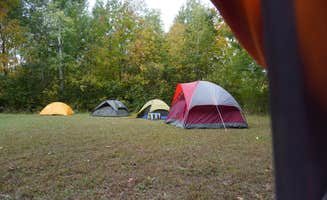Tent campsites around Wauwatosa, Wisconsin provide access to southern Wisconsin's glaciated terrain, oak savannas, and river systems. Most tent camping options require a 30-60 minute drive from the city limits, with the closest sites located in the Kettle Moraine State Forest system and along the Glacial Drumlin Trail corridor. Winter camping is available at select locations, though most campgrounds operate April through November.
What to do
Biking access: The Glacial Drumlin Trail connects to Wild Goose City Park in Juneau, offering tent campers a convenient stop. "It's a good place to stop and have a break. There's a playground and public bathroom, drinking fountain. Plenty of space to spread out for a picnic when you're biking through," notes Kim L. from Wild Goose City Park.
Find water activities: Purplehaze Acres provides tent camping near local waterways with drinking water and toilets available on site. The 9 campsites allow both drive-in and walk-in access, making it suitable for campers with various equipment loads. Nearby lakes provide fishing and paddling opportunities within a short drive.
Pack appropriately for terrain: At backpacking sites like those at Greenbush Campground, practical equipment makes a difference. "Large sites great for groups. Sites 2 and 9 are the largest. Those can each fit over 20 backpacking tents at the same time. Grassy sites surrounded by trees (plenty for hammocks too)," explains Amber R. Most backcountry sites require carrying in all supplies over varying terrain.
What campers like
Privacy and seclusion: Backpacking shelters provide quieter alternatives to drive-in campgrounds. "Great backpack camp site. Decent walk and terrain to get to the site. There is an open shelter to put your tent if you prefer to outside," writes Erin Z. about KMSF Shelter 1 Backpack Site. Most backpacking sites require hiking 1-3 miles to reach the campsite location.
Affordable options: County parks like Waubedonia County Park offer budget-friendly tent camping with basic amenities. "A nice little campgeound near the river in Fredonia, WI. The campsites are inexpensive and comfortable, though there aren't as many amenities that a larger campground would have," shares Kevin S. Sites typically cost $15-25 per night depending on residency status.
Group site flexibility: For larger gatherings, dedicated group sites provide more room to spread out. "We booked this for a coronavirus-safe camping trip, and it did not disappoint. Water is usually available, but more limited during the pandemic. We had six tents, but the site could easily have accommodated more," reports Hilary S. about Northern Unit Greenbush Group Camp. Most group sites accommodate 8-25 people with additional parking.
What you should know
Site selection matters: Noise travels between campsites at group campgrounds like Northern Unit Greenbush. "The nine sites are visually separated, but not far enough away from each other to block louder noise - we could hear loud music from the site 4 late into the night," warns Hilary S. Corner sites typically offer more buffer space from neighboring campers.
Seasonal considerations: Insect activity varies dramatically by season in Wisconsin's wetland areas. "The sites are really near some stagnant water, though, so WAY too many mosquitoes, even with the really intense bug spray. I do believe these would be lovely sites in the fall or Spring, though," advises Tawnie T. about Sandhill Station State Campground. Most tent campers report better conditions from September through early October.
Firewood sourcing: Most tent sites restrict outside firewood due to invasive species concerns. Backpackers at KMSF Shelter 1 report, "There is a fire pit, but we found our own wood around the site. (Bring a small axe)." State parks require purchasing certified firewood within 10 miles of the campground.
Tips for camping with families
Carry-in logistics: Plan for equipment transportation at walk-in sites. "The parking lot is anywhere from 100-500 yards from the campsite, depending on which one you choose. There isn't anywhere to buy firewood, so buy from a local resident/gas station," notes Jimmy P. about Sandhill Station. Most families find wagons helpful for transporting gear and children to walk-in sites.
Facilities access: Bathroom options vary widely between campgrounds. At Little Turtle Lake, the 5 tent sites include toilet facilities but no drinking water, requiring families to bring their own supply. Most established campgrounds maintain pit toilets within 100-200 yards of campsites.
Educational opportunities: Several campgrounds provide access to natural and historical attractions. "Nearby is Aztalan State Park and Aztalan museum. The state park is beautiful grassland and prairie, and the Crawfish River flows along side the park," writes Jimmy P. about activities near Sandhill Station. Many parks offer junior ranger programs during summer months.
Tips from RVers
Boat-in access: For unique camping experiences, Cappie's Landing offers boat-in tent sites with minimal facilities. These sites provide alternatives for RVers seeking different experiences from their usual setup. Canoe and kayak campers can access sites from multiple water entry points.
Space constraints: When traveling with both RV and tent campers, Little Turtle Lake's 5 designated tent sites offer a compact footprint. RVers report that advance planning is essential since the small campground fills quickly during peak season. Non-reservable sites typically fill by Thursday afternoon during summer months.



